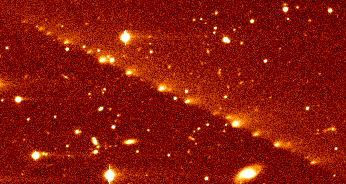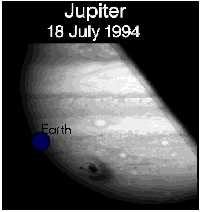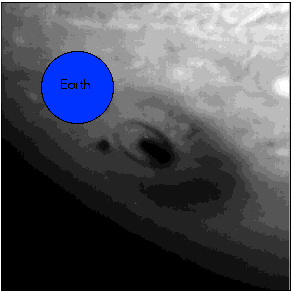
Fig. 1
(updated 3-18-97)

Fig. 1
At first JPL estimated the "chunks" of broken comet to be from an eighth of a mile in diameter to one quarter of a mile in diameter. It is interesting to note that this figure rose to two to four miles in radius, after the impacts. Also of interest was the fact that the Hubble Space Telescope was repaired only six months prior to the impacts. And of course other than those first few photos, it took six months after the impacts before they released any reliable data of the event.
I remember watching the JPL scientists cheer and drink salutes to what I beheld with awe and fear. I thought, "but for the grace of God...". Indeed this was a new event in the history of our astronomical observations, but the action of the NASA/JPL scientists could only be categorized as whimsical and giddy. Few of these individuals expressed the reverence and profound respect one would expect of professionals.

fig. 1a
Over a thousand Earths would fit into the capacity of Jupiter. This picture reflects the relative size (approximately) of the effect of impact "G" to our planet. JPL scientists at first reported that there would be a minimal effect, due to the gaseous makeup of Jupiter. Minimum effect ?
Each mountain hurled down upon Jupiter delivered a minimum of a hundred and twenty million megatons of explosive destruction. Hardly minimal. And from images we can see that each impact left an unmistakable scar upon the face of the Jovian surface.
The infrared images released six months after the event, but almost six months old, left no doubt that the impacts had internally affected Jupiter. The images showed that there was internal heating at both poles. But these and other images soon disappeared from the public eye.
In March and July of 1995, Io, one of Jupiter's moons, displayed massive volcanic eruptions; flashes two hundred miles into space! Perhaps SL9's effects upon the internal mechanisms of Jupiter, primarily Jupiter's field production, was heavily influenced.

Fig. 1b
Some say that Jupiter is our protector due to its size and ability to attract these dangerous objects that exist in our solar system. One has to look no further than to our own moon to understand the foolishness of this statement. It is pock-marked and scarred from hundreds of previous encounters. Then there is other evidence in our other close neighbors; Venus, Mercury, and Mars. All of which have suffered hundreds, even thousands of meteor and comet impacts.
In fact, in the past few years NASA has begun to take this threat serious. They have organized NEAT, a project with at least two surveying observatories, that are rushing to catalogue and assess the threat of Near Earth Objects. Part of this project co-sponsored by the Air Force titled AMOS, has spent millions of dollars building specialized instruments on the highest mountain in Hawaii.
One interview with a scientist from NEAT
stated at their current rate of cataloging these objects, it will take
over fifty years to complete even their first phase.
So is Hale Bopp a threat? As of now...no. At least it will not collide with the Earth on its current trajectory. But as Shoemaker Levy 9 proved, everything can change. There are no guarantees and very few comparatively established facts in our universe. There are numerous impact craters being discovered every year right here on Earth. A direct hit of an object of any size would be devastating.
The officials play the numbers and percentages game, such as, we have a one in one hundred thousand chance of being hit by anything big enough to create damage. Or an object big enough to harm the Earth will only hit us every ten thousand years.
Let's just hope that we don't live in that one year that it does
hit! At least now NASA/JPL is beginning to consider the possibility of
such an event.
Update 2-23-97
Is our solar system "calming down"?
Have all of the calamities disappeared with age?
The above example shows that our system is not a system "at rest". The following example of powerful destruction occurred most recently in December of 1996.
It was recorded by the SOHO/LASCO team.
In late December 1996, the group obtained a motion picture of the Sun as it sailed in front of the stars of the Sagittarius constellation and the Milky Way, while blowing its solar wind outwards in all directions around it. In the movie, the Sun is seen "swallowing" a comet that is known to the scientific team as Comet SOHO-6. Several coronal mass ejections are seen as visible puffs of gas.
Four images from the EIT instrument, taken in the ultraviolet coronal line of Fe XII, are shown in Fig. 1. Cool material (dark) ascends from the solar surface (20:32 universal time (UT)) to form a loop-like structure at 20:41 UT, which explodes, reaching an altitude of 300,000 km in 12 minutes.
At 20:53 UT, the exploding material has accelerated to a velocity of 400 km/second. The cool material pushes in front of it a coronal (hot) shockwave, which can be seen as a bright circle. The shockwave was also recorded by the inner coronagraph of the LASCO instrument (Fig.2) at 21:04 and 21:07 in two different wavebands at an altitude of 450,000 km.
Update 3-18-97
These comments which I have recently come across demonstrate some of the lack of understanding that the status quo of the astronomical community really have about the variable nature of comets (asteroids?). Prior to the strike of SL9 on Jupiter astronomers were discouraging the public from expecting too much.
In a number of days before the event, astronomers all over the world were actually discouraging the public from trying to see the comet crash through a small telescope. Donald Savage July 7, 1994 NASA Headquarters, Washington, DC. stated:
"Because of its small size, most scientists do not expect to witness significant visible effects from the impact of the first fragment, nor to detect significant after-effects in the planet's atmosphere."
In another quote, Paul Weissman July 13, 1994 in Nature July 14, article titled: "The Big Fizzle is Coming" stated:
"Each snowball will individually ablate and burn up like a meteor in Jupiter's upper atmosphere. Lacking the momentum and the structural integrity of a single solid body, they will likely not penetrate deeper into the atmosphere where they might explode with multi-thousands of megatons of energy.
Thus the giant impacts will produce a spectacular meteor shower, but not the massive fireball explosions that have been predicted by some researchers. The impacts will be a cosmic fizzle."
Did he say "snowball"? What will those silly guys say next!
I have also received this communication, written by a widely published professional astronomer at a major U.S. observatory:
The key argument for SL9 not being a comet is that observers never found water in it. The major difference between a comet and an asteroid is water. However, it is not always clear if an object has water or not as seen from the ground.
A real comet could look like an asteroid if,
1) it is far away from the sun, i.e. it's not hot enough yet to force vaporization, or
2) it has stayed close to the sun so long that is has lost all of it's 'surface layer' of ice.Since the heat is not able to penetrate into the interior of a 10km sized object, at the age of the solar system, it is very hard to say if what we see is a comet in the second case, or an asteroid when the object has a small semi-major axis.
Historically, people claim that they find comets if they can see a coma, and asteroids if they don't. They always keep an eye on those objects with high eccentricities, because they are the ones most likely to show cometary behaviors in certain stages of their lifetime.
As vast amounts of dust scattered around SL9, when it was found, it appeared to be coma. Some then claimed immediately that is was a comet; however no water was ever found so others still prefer to call it an asteroid. We now know that its coma was induced by the break-up, not by sublimation of volatile materials.
And it was also determined that SL9's orbit was highly eccentric before it's captured by Jupiter ...It is a long story, and as far as I know to this day there was no agreement on this point before or after the impact on Jupiter.
There are powerful forces that surround us that NASA is taking seriously, shouldn't we?